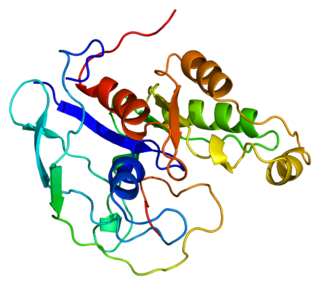Programmed cell death protein 4 is a protein that in humans is encoded by the PDCD4 gene. [5] [6] It is one of the targets of an oncomiR, MIRN21. [7]
Programmed cell death protein 4 is a protein that in humans is encoded by the PDCD4 gene. [5] [6] It is one of the targets of an oncomiR, MIRN21. [7]
This gene encodes a protein localized to the nucleus in proliferating cells. Expression of this gene is modulated by cytokines in natural killer and T cells. The gene product is thought to play a role in apoptosis but the specific role has not yet been determined. Two transcripts encoding different isoforms have been identified. [6]
PDCD4 has been shown to interact with RPS13, [8] ribosomal protein L5, [8] p62, LC3 and Ubiquitin [9]

Merlin is a cytoskeletal protein. In humans, it is a tumor suppressor protein involved in neurofibromatosis type II. Sequence data reveal its similarity to the ERM protein family.

Calcium/calmodulin-dependent protein kinase type II beta chain is an enzyme that in humans is encoded by the CAMK2B gene.

60S ribosomal protein L5 is a protein that in humans is encoded by the RPL5 gene.

DnaJ homolog subfamily A member 3, mitochondrial, also known as Tumorous imaginal disc 1 (TID1), is a protein that in humans is encoded by the DNAJA3 gene on chromosome 16. This protein belongs to the DNAJ/Hsp40 protein family, which is known for binding and activating Hsp70 chaperone proteins to perform protein folding, degradation, and complex assembly. As a mitochondrial protein, it is involved in maintaining membrane potential and mitochondrial DNA (mtDNA) integrity, as well as cellular processes such as cell movement, growth, and death. Furthermore, it is associated with a broad range of diseases, including neurodegenerative diseases, inflammatory diseases, and cancers.

Cyclin-dependent kinase 4 inhibitor B also known as multiple tumor suppressor 2 (MTS-2) or p15INK4b is a protein that is encoded by the CDKN2B gene in humans.

Activated CDC42 kinase 1, also known as ACK1, is an enzyme that in humans is encoded by the TNK2 gene. TNK2 gene encodes a non-receptor tyrosine kinase, ACK1, that binds to multiple receptor tyrosine kinases e.g. EGFR, MERTK, AXL, HER2 and insulin receptor (IR). ACK1 also interacts with Cdc42Hs in its GTP-bound form and inhibits both the intrinsic and GTPase-activating protein (GAP)-stimulated GTPase activity of Cdc42Hs. This binding is mediated by a unique sequence of 47 amino acids C-terminal to an SH3 domain. The protein may be involved in a regulatory mechanism that sustains the GTP-bound active form of Cdc42Hs and which is directly linked to a tyrosine phosphorylation signal transduction pathway. Several alternatively spliced transcript variants have been identified from this gene, but the full-length nature of only two transcript variants has been determined.

60S ribosomal protein L10 is a protein that in humans is encoded by the RPL10 gene.

Calcium/calmodulin-dependent protein kinase type II delta chain is an enzyme that in humans is encoded by the CAMK2D gene.

60S acidic ribosomal protein P1 is a protein that in humans is encoded by the RPLP1 gene.

40S ribosomal protein S13 is a protein that in humans is encoded by the RPS13 gene.

Large tumor suppressor kinase 1 (LATS1) is an enzyme that in humans is encoded by the LATS1 gene.

Microtubule-associated serine/threonine-protein kinase 2 is an enzyme that in humans is encoded by the MAST2 gene. The protein encoded by this gene controls TRAF6 and NF-kappaB activity.

Connector enhancer of kinase suppressor of ras 1 is an enzyme that in humans is encoded by the CNKSR1 gene.

55 kDa erythrocyte membrane protein is a protein that in humans is encoded by the MPP1 gene.

Large tumor suppressor kinase 2 (LATS2) is an enzyme that in humans is encoded by the LATS2 gene.

Ras suppressor protein 1 is a protein that in humans is encoded by the RSU1 gene.

Glucocorticoid receptor DNA-binding factor 1 is a protein that in humans is encoded by the GRLF1 gene.

Maternal embryonic leucine zipper kinase (MELK) is an enzyme that in humans is encoded by the MELK gene. MELK is a serine/threonine kinase belonging to the family of AMPK/Snf1 protein kinases. MELK was first identified present as maternal mRNA in mouse embryos. MELK expression is elevated in a number of cancers and is an active research target for pharmacological inhibition.

Glioma tumor suppressor candidate region gene 2 protein is a protein that in humans is encoded by the GLTSCR2 gene.

Protein salvador homolog 1 is a protein that in humans is encoded by the SAV1 gene.
9. Manirujjaman M, Ozaki I, Murata Y, Guo J, Xia J, Nishioka K, Perveen R, Takahashi H, Anzai K, Matsuhashi S (2020). "Degradation of the Tumor Suppressor PDCD4 Is Impaired by the Suppression of p62/SQSTM1 and Autophagy". Cells. 9(1): 218. doi.org/10.3390/cells9010218.